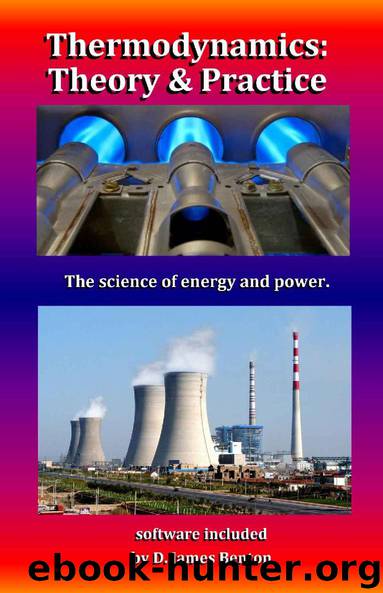Thermodynamics: Theory & Practice: The science of energy and power. by D. James Benton

Author:D. James Benton [Benton, D. James]
Language: eng
Format: epub
Published: 2016-10-24T22:00:00+00:00
...You must use the same reference for all of the properties and the heating value; otherwise, you will introduce errors into the calculation. The following figure illustrates this problem:
...The following simplifications will be made to facilitate this example:
1) The fuel is pure methane.
2) There is no water or steam injection.
3) There is no bleed off of the compressor.
4) There is no gear loss (i.e., a dual-shaft engine).
5) The impact of fuel pressure on sensible heat is negligible.
6) The trace gases found in air (Hydrogen, , Neon, Krypton, Xenon Methane, and Sulfur Dioxide) can be lumped together with Helium, Argon, or Carbon Dioxide.
7) Complete combustion without NOx formation.
8) The heat loss can be characterized by an assumed percentage of the total heat input.
...This problem is solved by first calculating the amount of oxygen required for combustion of the fuel. This has been hardwired into the Excel® spreadsheet for methane, but can be generalized using a table, as in the more complete spreadsheet, which is also included in the on-line archive. The fuel composition can also be generalized using tables (also in the more complete example).
...The enthalpy is then calculated for each of the streams entering and leaving. This is done by considering the dry air required for stoichiometric combustion, the excess dry air, the moisture (water vapor) brought in with the dry air, the fuel, and each of the products of combustion as separate streams. These streams are entirely mixed, but the chemical species are considered separate and properly accounted for, so that the end result is the same. All of the enthalpies-including the moist air at the inlet-are calculated at the same reference condition: 25ºC/77ºF.
...By considering the dry air required for combustion separate from the excess air, this adds an equation and eliminates the necessity of an iterative solution, as is the case if the combustion and excess air are considered jointly. The water vapor in the exhaust is equal to that brought in with the dry combustion air plus that brought in with the excess air plus that resulting from hydrocarbon combustion. The same is true for the carbon dioxide. The results are shown in the following figure for SI units. A second tab in the spreadsheet provides the same calculations only with English units.
...Note that the enthalpy of a mixture of gases must be calculated on a mass fraction basis, not a mole fraction basis. Fuel gas composition is most often provided on a mole fraction basis, so this must also be considered when solving this problem for a mixture, such as natural gas. Also remember that the humidity ratio (mass of water vapor per mass of dry air) must be used and not relative humidity, which is a percentage of saturation and not a mass-based property.
...It is also important to use what is called the Lower Heating Value (LHV) of the fuel and not the Higher Heating Value (HHV). There are different definitions of lower and higher heating value. The correct definition depends on whether the water resulting from combustion is in the vapor or liquid state.
Download
This site does not store any files on its server. We only index and link to content provided by other sites. Please contact the content providers to delete copyright contents if any and email us, we'll remove relevant links or contents immediately.
| Fluid Dynamics | Thermodynamics |
The Complete Stick Figure Physics Tutorials by Allen Sarah(7338)
Secrets of Antigravity Propulsion: Tesla, UFOs, and Classified Aerospace Technology by Ph.D. Paul A. Laviolette(5333)
Thing Explainer by Randall Munroe(3909)
The River of Consciousness by Oliver Sacks(3572)
The Order of Time by Carlo Rovelli(3162)
How To by Randall Munroe(3074)
A Brief History of Time by Stephen Hawking(2991)
I Live in the Future & Here's How It Works by Nick Bilton(2960)
What If?: Serious Scientific Answers to Absurd Hypothetical Questions by Randall Munroe(2667)
The Great Unknown by Marcus du Sautoy(2662)
Midnight in Chernobyl by Adam Higginbotham(2516)
Blockchain: Ultimate Step By Step Guide To Understanding Blockchain Technology, Bitcoin Creation, and the future of Money (Novice to Expert) by Keizer Söze(2467)
Networks: An Introduction by Newman Mark(2382)
The Meaning of it All by Richard Feynman(2319)
Easy Electronics by Charles Platt(2308)
The Tao of Physics by Fritjof Capra(2247)
Midnight in Chernobyl: The Untold Story of the World's Greatest Nuclear Disaster by Adam Higginbotham(2195)
When by Daniel H Pink(2098)
Introducing Relativity by Bruce Bassett(2097)
